Baby’s teeth order sequence: As a parent, you will be excited when you see the babies start to grow their first teeth, but just like adults, babies will be uncomfortable, they will not express their discomfort through other symptoms, soAll parents should understand the babies’ teething.When will the babies make their teeth and what are the symptoms of teething?How to help babies relieve discomfort, and do they need to brush their teeth like adults?
Directory of this article
- How many stages do babies have teeth?
- What is the order of baby deciduous teeth?
- What is the order of the baby’s permanent teeth?
- What are the symptoms when the baby is gone?
- The baby’s teeth are uncomfortable, how to deal with it?
- What drugs can babies use uncomfortable teething?
- How to care for the baby’s mouth?
- Can a baby use fluorine toothpaste?
- How to cultivate your baby’s good habit?
- references
- common problem
How many stages do babies have teeth?
Baby teeth usually have two stages: Deciduous teeth(DECIDUOUS TeetH or Children ’s Teeth) and the Permanent teeth(Permanent TeetH).Among them, the long permanent teeth include the original deciduous teeth fall off and replace the new teeth, and also include a few new teeth.Generally speaking, deciduous teeth have a total 20 pieces And permanent teeth are generally available 32 pieces, Perida is smaller and whiter than deciduous.
1.Beneys
The baby’s deciduous teeth refer to the first deciduous teeth on the gums of the babies, and then they will continue until the baby is three years old.In the mouth of the babies, a total of 20 deciduous teeth are president.10, as shown in the figure below:
Label 1-10 is the 10 deciduous teeth of the mandibular, and the left and right sides are completely symmetrical.From#1 ~#10 are:
- #1: The second mandibular grinding teeth
- #2: The first mandibular grinding teeth
- #3: Mandarin dogs/molars
- #4: Mandarin side cut teeth
- #5: Cut the teeth in the jaw
- #6: Same#5,Dist in the mandibular
- #7: Same#4,Mandarin side-cut teeth
- #8: Same#3,Mandibular dog teeth
- #9: Same#2,Mandarin first grinding teeth
- #10: Same#1,Mandarin second grinding teeth
Label 11-20 is the 10 deciduous teeth of the upper jaw, and the mandibular teeth are also one by one.At the same time, the left and right sides are completely symmetrical.
- #11: Mandarin second grinding teeth
- #12: The first mandibular grinding teeth
- #13: Mandarin dogs/molars
- #14: Mandarin side cut teeth
- #15: Cut the teeth in the upper jaw
- #16: Same#15,Matter
- #17: Same#14,Mandarin side-cut teeth
- #18: Same#13,Jaw
- #19: Same#12,Mandarin first grinding teeth
- #20: Same#11,Mandarin second grinding teeth
2.Perida
Most of the deciduous teeth will be replaced in the childhood period (about six years old), becoming permanent teeth.At the same time, in addition to 20 replaced deciduous teeth, the babies will have 6 pairs of new teeth (12) new teeth.Among the 12 new teeth, 6 are mandibular and 6 are in the jaw.
As shown in the figure below: Label 1-10, 11-20 is the permanent teeth after the deciduous teeth are replaced, and the label 21-23, 24-26, 27-29, 30-32 is a new teeth that will grow afterwards.
Among them, the first forestein (FIRST PREMOLAR) is replaced by the first grinding teeth of the deciduous teeth, and the second foreskin (Second Premolar) is replaced by the second grinding teeth of the deciduous teeth.
What is the order of baby deciduous teeth?
According to most babies’ deciduous teeth, the order of the baby’s teeth is roughly:
Baby teething time | Baby’s deciduous teeth |
|---|---|
| About 6 to 10 months | The middle of the jaw is often said to be the lower part |
| About 8 to 12 months | The middle cut of the upper jaw is often said to be the upper tooth |
| About 9 to 13 months | The side of the upper jaw is the two smaller teeth on both sides of the upper tooth |
| About 10 to 16 months | The side of the mandibular cut is the two smaller teeth on both sides of the lower incisor |
| About 13 to 19 months | The first molar of the upper jaw is the tooth behind the tiger’s teeth |
| About 14 to 18 months | The first molar of the mandibular is the tooth behind the tiger’s teeth |
| Around 16 to 22 months | The canine teeth of the upper jaw are the tiger teeth |
| Around 17 to 23 months | The canine teeth of the jaw are the lower tiger teeth |
| About 23 to 31 months | The second grinding teeth of the mandible |
| About 25 to 33 months | The second grinding teeth of the upper jaw |
It can be seen from the baby’s teething schedule:
- First of all, the baby’s teeth have a range.For example, the first tooth usually grows in about 6 or 10 months, so when the baby is 6 months, but there is no teeth, parents don’t have to worry too much.
- Second, the order of the baby’s teeth may be reversed.From the timetable, it can be seen that some teeth are overlapped, so if the baby grows up to the upper tooth and then grows into the income, it is normal.However, the order of the babies is closer to the sequence of the table in the table.
- Third, there are many factors that affect the baby’s teeth time and order, such as genes, gender, physique, life areas, and nutrition.Check the cause of the problem there.
What is the order of the baby’s permanent teeth?
About 6 or 7 years old, the babies started to change their teeth, that is, taking off the deciduous teeth and growing permanent teeth.At the same time, 12 new teeth will grow.In the figure below, the permanent teeth marked by black are replaced by deciduous teeth, and the marked blue permanent teeth are newly grown later.
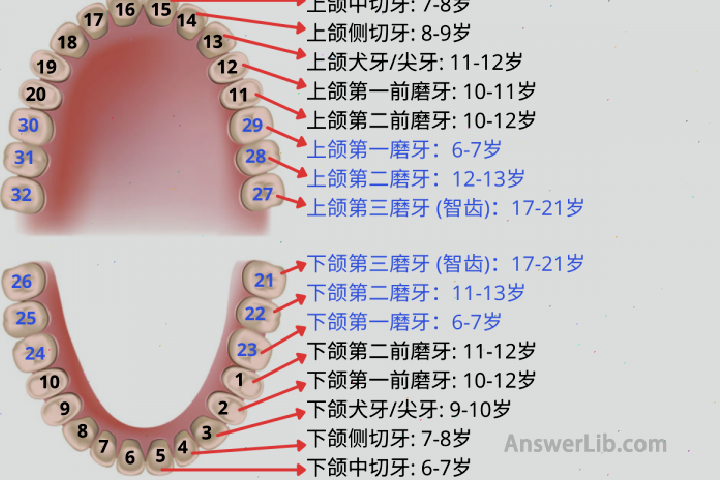
Baby’s teeth change time | Baby permanent teeth |
|---|---|
| 6 to 7 years old | Midtore |
| 7 to 8 years old | Midtore |
| 7 to 8 years old | The side cut of the mandibular |
| 8 to 9 years old | Mandarin tooth |
| 9 to 10 years old | Slow |
| 11 to 12 years old | Jaw teeth |
| 10 to 12 years old | The first grinding teeth of the mandibular switch to the first front grinding teeth |
| 10 to 11 years old | The first grinding of the upper jaw is replaced with the first foreskin |
| 11 to 12 years old | The second grinding teeth of the mandible is replaced with the second front grinding teeth |
| 10 to 12 years old | The second grinding teeth of the upper jaw is replaced by the second front grinding teeth |
| 6 to 7 years old | The first grinding teeth of the mandibular (new growing) |
| 6 to 7 years old | The first grinding teeth of the upper jaw (new growing) |
| 11 to 13 years old | The second grinding teeth of the mandibular (new growing) |
| 12 to 13 years old | The second grinding teeth of the upper jaw (new growing) |
| 17 to 21 years old | The third grinding teeth of the mandible, which is often referred to as wisdom teeth (new growing) |
| 17 to 21 years old | The third grinding teeth of the upper jaw, which is often referred to |
What are the symptoms when the baby is gone?
Similar to the feelings of adults, the babies are also very uncomfortable when they have teeth.The gums will be squeezed and broken when the gums are gone.
- Grancoloral, crying and making trouble: This is the most common situation.Babies will not express their discomfort through language, so they can only express it through the most direct emotions.If the babies suddenly express at the age of the normal tooth periodIt may be to teething to show a lot of love and crying.
- The baby’s sleep is not good: the babies are uncomfortable in the daytime, and they are irritable during the day, and they are manifested as poor sleep at night.They may cry and make trouble when they fall asleep, or they can’t sleep well.
- Love to bite things: Gingival discomfort during the teething period, can be relieved by stinging things, so during teething, babies will be able to get everything, especially cold and hard things, such as tableware, dining tables.
- Love flowing: This is one of the most common situations during the baby’s teething.The saliva is completely unsuitable, and there are many.
- The gums are swollen and the cheeks are red: Parents are easy to find this situation when feeding or cleaning the baby’s mouth.Without other diseases, this kind of situation is usually caused by teething.
- Baby body temperature increases: When hugging the baby or cleaning the baby’s skin, the body temperature may be higher than before, but it has not reached the point of fever, but sometimes, teething may cause fever.
- Diaper rash: During the tooth out of teething, the baby’s stool may become thinner, which may lead to diaper rash.
The baby’s teeth are uncomfortable, how to deal with it?
For the various discomforts showed by the baby, parents know how to deal with the tooth out of the dental period.
- Aiming at irritability, crying and making trouble: You can disperse their attention by playing with babies, bringing babies to outdoor activities, etc., or soothe their emotions through embrace and ballads.
- For poor sleep: You can wipe the baby’s gums with cold soft cotton cloth before going to bed, so that the baby enters sleep in a more comfortable state.
- Bite things for your baby: First of all, parents need to collect dangerous items at home during this time, especially the small parts and sharp items that are prone to crushing and crushing.Carrots, etc., help them relieve their gums uncomfortable safely.
- Drawing for the baby’s love: Soft cotton-made fences on the baby’s neck to avoid wet clothes from drooling.At the same time, you can also help wipe your saliva in time and remember to replace the fence in time.
- For gum swelling and red cheeks: When the swelling is not too serious, you can gently wipe the cold cotton cloth to relieve discomfort.If the swelling is too serious, you can contact a professional pediatrician to get nursing guidance.
- For the rise of body temperature: When the body temperature rises but has not reached the degree of fever, you can appropriately reduce the baby’s clothing to help heat dissipation.If the temperature of the body temperature is too high, you can take care of the guidance of the use of medication below.
- For diaper rash: Once you find that your baby’s stool is diluted, it increases the frequency of changing your baby’s diaper.At the same time, you can apply some skin creams that prevent diapers to protect the skin of your baby’s hips.
What drugs can babies use uncomfortable teething?
For pain and fever, American Pediatric Society ( American Academy of Pediatrics) It is proposed that babies with more than 3 months can provide the corresponding measurement to alleviate and treat the corresponding measurement to the corresponding measurement.[1]Therefore, after 3 months, babies showing obvious pain or fever can be taken according to weight, which can be taken according to weight.
At the same time, infants and young children over 6 months can also relieve pain and fever based on taking drugs containing ibuprofen under the guidance of a doctor or under the guidance of a doctor.[2]For example, motrin et al.[3]The effect is similar to the acetaminol.
At the same time, you can take your baby before going to bed to help them get better sleep.
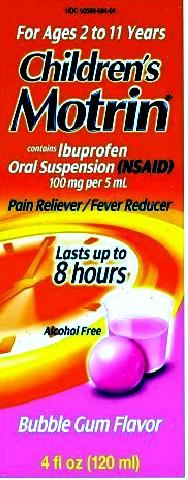
Affiliate Link
Motrin containing ibuprofen, suitable for young children aged 2 to 11, do not add alcohol, make the bubble sugar flavor that babies like, can be accurately available with a measuring cup, and the effect can last for 8 hours.
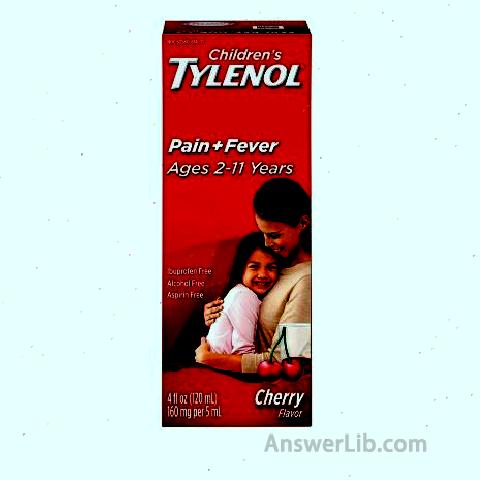
Affiliate Link
Suitable for acetylphenols used for children aged 2 to 11, cherry flavors will make babies willing to cooperate with them, without ibuprofen, alcoholic and without aspirin, can help the baby relieve pain and fever according to the instructions.Essence

Affiliate Link
The acetaminophen drugs, which are 2 to 3 years old, are acetaminophenophen drugs, cherry flavors, use of syringe-type drug tubes, have a scale, can accurately measure the drugs, and at the same time are convenient to feed them with low-aged babies.Lawen, alcohol and aspirin.
Parents need to pay attention to that some of the past to relieve the baby’s tooth pain have been verified as harmful and should be avoided.
For example, analgesic gels used in the past, such as Anbesol, Orajel, Baby Orajel, Orabase, etc., because it contains non-prescription anesthesia bencaine, and the substance is proven to be proven to a serious disease called high-speed rail hemoglobin ledis.[4]EssenceTherefore, the FDA has declared that parents are advised to avoid using items containing benzoine in children under the age of 2[5]Essence
There are also more popular amber dental necklaces in the past, but this necklace is prone to be bitten by the baby, and the danger of swallowing occurs.[7]Essence
How to care for the baby’s mouth?
During the gap, the baby’s gums and gums will become very fragile due to squeezing, top breaking, and swelling, and need more care, especially after eating, when cleaning, it is mainly soft cotton cloth.
- You can use a soft cotton cloth: Parents put cotton cloth around their fingers, dip some water, and then wipe the baby’s gums.
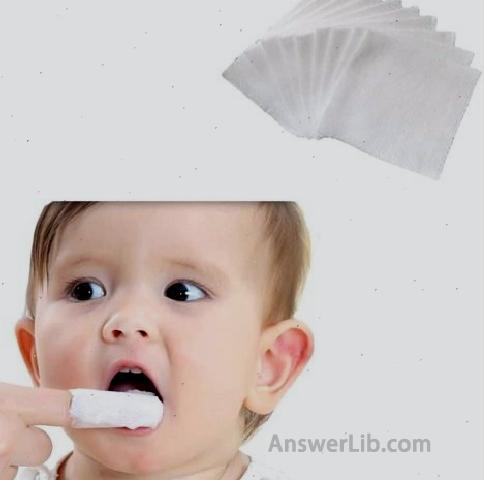
Affiliate Link
Pure white gauze support, the size can be around the adult fingers, and no residues such as cotton wool will be produced, which can help effective and gentle to clean the baby’s gums.
- Use some silicone toothbrushes to put on the adult finger to help clean the gums

Affiliate Link
The soft silicone material, the size is exactly on the adult’s fingers, it is not easy to slide, avoiding the baby’s swallowing danger.The soft silicone particles on the top of the toothbrush can not only effectively clean the baby’s teeth, but also help massage the gums and relieve the discomfort of the dental period.Essence
- If you use your fingers to clean your baby’s mouth, you will be bitten and you can use a long-handed silicone toothbrush.
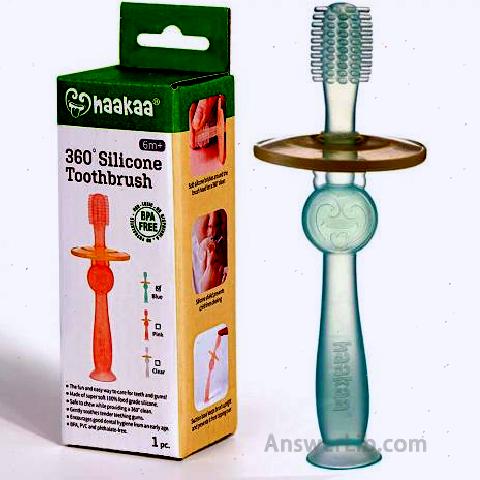
Affiliate Link
The soft silicone texture, effectively cleaning and massaging gums.The length of the handle is suitable for adults to grab.There are baffles, which can help control the depth of the baby’s mouth to avoid touching the throat and cause danger.
- You can also use a silicone toothbrush that babies can grab themselves to clean their teeth and gums while bite.
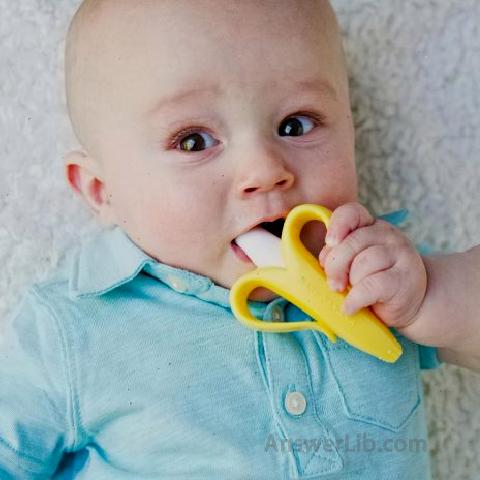
Affiliate Link
The shape of the banana shape is very suitable for the baby’s small hand to grab it, put it in the mouth to bite, the “skin” of the rubber can effectively prevent the toothbrush from penetrating the baby’s mouth to cause danger.The soft silicone particles on the top can clean the teeth while bite the baby and massage the gums.
- For babies with more teeth, you can use bristles toothbrushes to clean the gaps between teeth and teeth.

Affiliate Link
The super fine and soft bristles can effectively clean the baby’s deciduous teeth just growing, and will not paint the gums, but it can effectively clean the surface of the teeth and the gaps of the teeth.Learn yourself to brush your teeth and develop a good habit of maintaining oral hygiene.
- If the gap between the baby’s teeth is relatively small, you can prepare children’s dental floss for them to help deep clean.
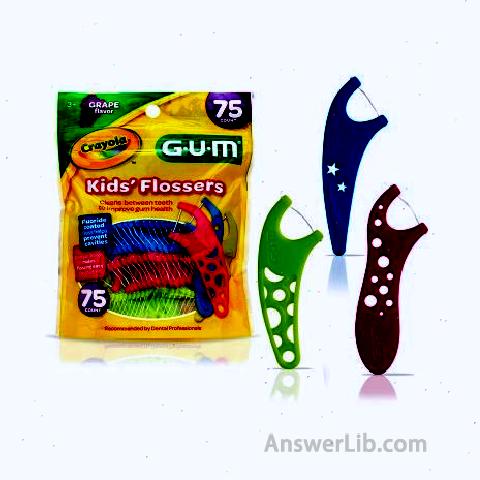
Affiliate Link
Gum and Crayola jointly launched the children’s pressure line.The cartoon color appearance is very popular with the baby.At the same time, it provides fruit flavors and will not be resisted by the baby.It will have fluoride coatings on the dental vens.More protection, I am not worried that the baby will swallow the excess fluoride.
Can a baby use fluorine toothpaste?
Whether to use fluoride ointment for your baby mainly depends on two points:
- Baby’s age
- Fluoride content in daily drinking water
A.Consider the age of the baby
Although fluoride is recognized as a substance that is beneficial to the teeth, it is not the case for babies during deciduous teeth.According to CDC, when children are 8 years old, they will consume fluoride regularly when they are 8 years old.It will lead to a disease that causes the appearance of the enamel.[6] Essence
So CDC suggests:
- For infants under the age of 2, you should immediately start cleaning your teeth after growing your first teeth.With a toothpaste, use small soft hair toothbrushes and clear water to brush your teeth.
- For children aged 2 to 6, they can apply fluorine toothpastes that do not exceed the size of peas on the toothbrush, and supervise them to brush their teeth.At the same time, because children under the age of 6 are poorly controlled by swallowing reflection, children should be encouraged to spit out toothpaste.
B.Consider the fluoride content in daily drinking water
People have recognized the importance of fluoride to teeth, so there are more fluoride in life, such as fluorine-containing drinking water.In such an environment, use fluorine toothpaste for young children, especially these toothpastes are used as young children.When swallowing, it can easily lead to the production of fluoride.
Parents can inquire about the fluoride content in the water in the home through the water supply system, and tell them that they need to use fluoride toothpaste to use fluoride toothpaste.
Here are several safe babies with fluorine toothpaste:
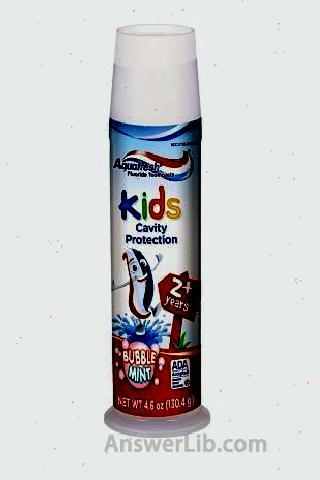
Affiliate Link
The pump-type foam mint children’s anti-tooth decay balm supports children over 2 years of age, safe fluorine-containing formula, which effectively helps teeth to prevent moth.The foam mint flavor will not be too spicy, and it will bring a good breath.
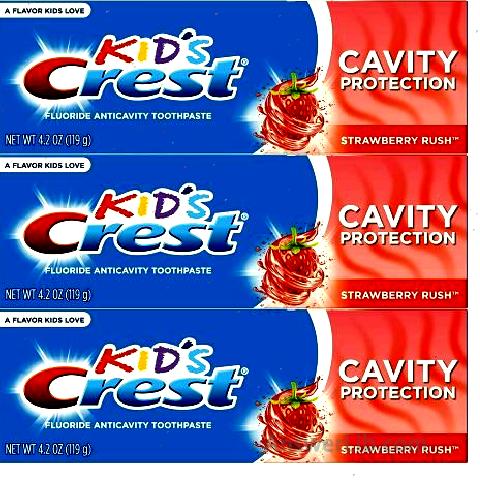
Affiliate Link
Children’s toothpaste launched by well-known oral nursing brands Crest, interesting whirlwind strawberry flavor, all children will love, fluoride-containing formulas, can safely provide effectively providing effectively and supporting children over 2 years old.
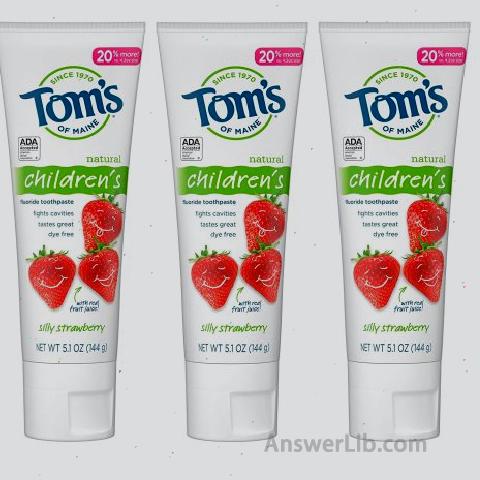
Affiliate Link
Children’s anti-tooth decay paste without artificial preservatives, pigments or spices, fluoride-containing formulas can provide effective anti-mothing, smelling strawberry water fruit flavor, helping babies accept toothpaste, and develop a good habit of actively brushing teeth.

Affiliate Link
Children’s safety anti-tooth decay balm, mild fruit flavor and fluorine-containing formula recognized by the American Dentist Association can effectively help fresh breath and dental protection, pump design, and allow the baby to easily complete the brushing process independently.
How to cultivate your baby’s good habit?
1.Accompany the brushing, lead by example
Babies like to imitate their parents, so parents can start from themselves, develop the habit of brushing their teeth every morning and evening, and use dental floss.The baby will be happy to imitate the parents to complete these things.
2.Watch oral health education cartoons
Through the cartoon form that babies like, how to destroy the teeth during the oral care process, how can brushing the teeth protect the teeth, so that the baby can better understand the purpose of brushing, and to actively develop to maintain it.Good habits of oral cleaning.
3.Check regularly and cooperate with the doctor to encourage your baby to adhere to good habits
Starting from the baby’s first teeth, parents can take the baby to check their teeth every six months to let the baby get used to the examination of dentist.the teeth of.
references
[1] ACETAMINOPHEN DOSING TABLS for FEVER and Pain in Children. Medication Safety, Health Children.
[2] Written by university of Illinois, Medically Review by Lindsay Slowiczek, Pharmd.Ibuprfen vs.ACETAMINOPHEN: How are they different? Healthline, August 29, 2018
[3] Written by the university of Illinois, Medically Review by the University of Illinois.Infant Dosage for Motrin: How much Should I Give My Child? Healthline, August 31, 2016
[4] Written by Sandy McDowell, Medically Reviewed by Alana Biggers, M.D., MPH, MPH, What is methemoglobinemia? Healthline, September 1, 2018
[6] Fluorosis, Center for Disease Control and Prevention
[7] Teething NextLaces and Beads: a Caution for Parents. Teething and tooth care, health children.
common problem
Question 1: When will the baby’s deciduous teeth usually grow?The first teeth usually grow in about 6 or 10 months, but different babies will be different.Generally, the middle cut teeth of the mandible, that is, the two large incisors will grow first.
See More
Similar to the feelings of adults’ wisdom teeth, the babies are also very uncomfortable when they have teeth.The gums will be squeezed and broke when the gums are gone.Sleep, bite things, drool, swollen teeth, red cheeks, sometimes, the baby’s body temperature will rise, or diaper rash.
See More
